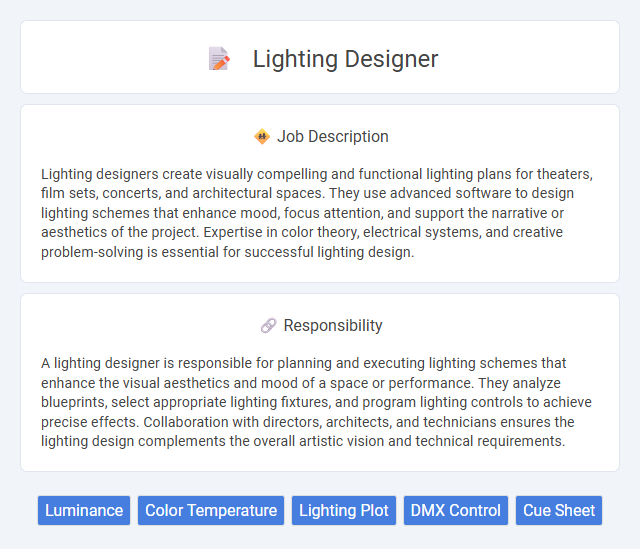
Lighting designers create visually compelling and functional lighting plans for theaters, film sets, concerts, and architectural spaces. They use advanced software to design lighting schemes that enhance mood, focus attention, and support the narrative or aesthetics of the project. Expertise in color theory, electrical systems, and creative problem-solving is essential for successful lighting design.
Individuals with a strong visual creativity and attention to detail are likely well-suited for a lighting designer role, as this job demands precision in color, intensity, and ambiance control. People who enjoy collaborative environments and can work under pressure to meet deadlines might find this career fulfilling and manageable. Conversely, those who prefer solitary work or have difficulty adapting to fast-paced, dynamic project requirements may find the role challenging.
Qualification
Lighting designers must possess strong knowledge of lighting technology, color theory, and design principles to create effective visual environments. Proficiency in software such as AutoCAD, Vectorworks, or Lightwright is essential for drafting and planning lighting setups. A degree in theater design, architectural lighting, or a related field combined with hands-on experience in live events, theater, or film production significantly enhances qualification.
Responsibility
A lighting designer is responsible for planning and executing lighting schemes that enhance the visual aesthetics and mood of a space or performance. They analyze blueprints, select appropriate lighting fixtures, and program lighting controls to achieve precise effects. Collaboration with directors, architects, and technicians ensures the lighting design complements the overall artistic vision and technical requirements.
Benefit
A lighting designer likely improves visual experiences by creating atmospheres that enhance performances or spaces. This role probably offers creative fulfillment and opportunities to work on diverse projects, from theater productions to architectural installations. It may also provide job stability in industries that value innovative and technical lighting solutions.
Challenge
Lighting designers likely face the challenge of balancing artistic creativity with technical constraints to create visually compelling environments. They often need to adapt quickly to changes in project scope or unexpected venue limitations, requiring problem-solving skills and flexibility. Meeting tight deadlines while ensuring the lighting contributes effectively to mood, atmosphere, and safety can also present ongoing difficulties.
Career Advancement
Lighting designer careers offer significant opportunities for advancement through gaining expertise in lighting technology, design software, and project management. Building a strong portfolio with diverse projects in theater, film, and architecture enhances professional reputation and opens doors to senior roles such as lead designer or creative director. Networking with industry professionals and continuous learning through workshops and certifications drive career growth and higher earning potential.
Key Terms
Luminance
Lighting designers specialize in creating optimal luminance levels to enhance visual environments across theaters, events, and architectural spaces. They analyze light intensity, distribution, and color temperature to ensure functional and aesthetic illumination that meets safety and mood requirements. Mastery of luminance measurement tools and software enables precise control over light quality, improving spatial perception and atmosphere.
Color Temperature
Lighting designers expertly manipulate color temperature to create mood and atmosphere in various environments, from theaters to architectural spaces. By selecting specific Kelvin (K) values, such as warm tones around 2700K or cool tones near 6500K, they influence visual perception and emotional response. Precise control over color temperature enhances aesthetic appeal and functional clarity in lighting design projects.
Lighting Plot
A lighting designer creates detailed lighting plots that map out the placement, color, intensity, and focus of light fixtures for theater, film, or event productions. These plots serve as technical blueprints guiding electricians and crew during setup to achieve the desired visual atmosphere and mood. Mastery of software like AutoCAD or Vectorworks is essential for producing precise and adaptable lighting plots that enhance storytelling and audience experience.
DMX Control
Lighting designers specialize in creating visually dynamic environments by expertly programming DMX control systems to manipulate lighting fixtures, colors, and effects. Proficiency in DMX512 protocol allows precise synchronization of lighting elements for concerts, theater productions, and live events. Mastery of DMX controllers enhances creative flexibility, enabling seamless integration of automated and manual lighting cues.
Cue Sheet
A lighting designer creates detailed cue sheets to coordinate lighting changes precisely during performances, ensuring seamless transitions that enhance the narrative and mood. Cue sheets list each lighting cue with specific timing, intensity, color, and position settings, serving as a critical reference for lighting operators. Accurate cue documentation improves show consistency, facilitates communication among production teams, and aids in troubleshooting technical issues during live events.
 kuljobs.com
kuljobs.com